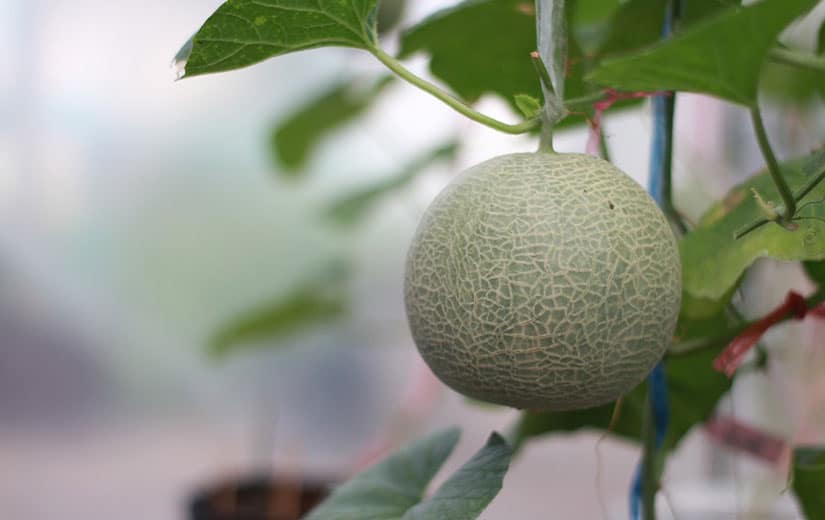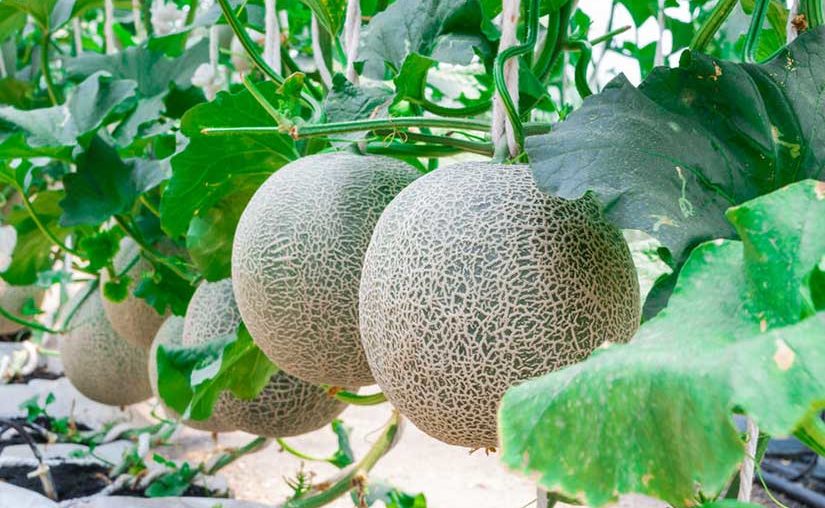Melon is a sweet and sweet fruit, mostly eaten during the summer. To germinate, the seeds need a lot of heat. This is why it is found in very sunny areas. However, even in areas with a more temperate climate, it is still quite easy to sow melon.
The necessary equipment
Cultivating melon is very easy provided you follow a few rules and have the right equipment available. For this you will need:
- Soil of leaves
- Manure or compost
- Peat buckets
- Chassis or mini greenhouse
- Fork
- Spade
- Manure or compost
- watering
- Spray
Which varieties to favor?

You want to sow melon, but you do not find yourself among all the varieties? We help you to see more clearly.
The star melon of the markets during the summer is the Cantaloup Charentaisbut it is far from the only variety available. Each has its own characteristics (color, shape, precocity, flavor) and their fruits are just as delicious.
But why cultivate other kinds of melon? The standardization of products sold in commerce leads to more rare or even total disappearance of certain species. To cultivate them is to preserve them! There are several categories of melons, each of which is available in several varieties.
The Cantaloups
Cantaloupe melons produce fruits between 1.2 kg and 1.8 kg. They are tasty, sweet and usually early, but they do not keep for a long time.
Among them is the Cantaloup Charentais, which we mentioned. It is an early variety with smooth skin, pale green in color, yellow when maturing, and juicy and orange flesh.
You can sow some melon of Bellegardeold, early, rustic variety, therefore resistant to lower temperatures. It is a vigorous plant and very productive.
The Black Carmelites is an early variety, easy to grow, very dark skin turning orange when ripe, which should not be harvested before. He produces big fruits, 1.5 kg on averagesweet and tasty, with thick flesh and orange.
The Prescott White Background is very profitable because it produces large-sized fruits, between 2.5 and 5 kg. It is rough and bumpy. The bark is greenish gray then orange-white when ripe. Juicy and fragrant, with orange-red flesh, it should be tasted when ripe. To avoid cluttering the foot, it is recommended to leave only one fruit.
The Embroidered
Like Cantaloups, embroidered melons produce small to medium sized fruit, between 500g and 1.8kgsweet and fragrant. These ancient varieties were cultivated in ancient Egypt, then in Greece and Rome. Their fruits have a raised corky skin and a rounded shape. The color of their flesh varies.
You will find in this category the melon Jenny Lindan early variety that easily adapts to the cooler climate and produces small fruits, between 0.5 and 1.5 kg. The fruits are round and flattened with well marked ribs, green skin and juicy and fragrant flesh. It takes space to cultivate because the plant tends to extend beyond 2 meters.
The Climbing Green is a runner variety that is grown on a trellis or fence. It produces small fruits between 500g and 800g, oval in shape, with dark green skin and speckled with light green. His flesh is green and juicy. The fruits should not be harvested too late because the skin becomes granular.
The sucrins
They are named after their high sugar content. TheRed-fleshed pineapplefor example, produces small round fruits of less than 500 g, dark green in appearance and embroidered and with red flesh. It is a runner variety that is grown on a trellis. The plant compensates for the small size of its fruits by its abundance.
As to Small gray of Rennesit produces medium-sized fruits, 1 kg on average, with smooth, thin, green skin with specks of green-gray. You will be able to bite into its orange and scented flesh after 85 days, when the skin is a little thinned. Like the American Pineapple, its production is generous. In addition, it is resistant to cooler temperatures.
Winter melons
This category of melon will give you large fruit, between 1.5 kg and 2.5 kg with pale flesh and oval and elongated. They keep longer than other varieties, but their flavor is sometimes less marked. They grow only in very hot climates or under heated chassis.
The Golden ball offers fruits of 1 to 2 kg Round in shape, with smooth, yellow skin and light green flesh. Collect it when the yellow of the skin intensifies. So, he will be very sweet. It is an ideal variety for small vegetable gardens as it does not spread and can carry up to 2 or 3 fruits. These last for up to several weeks but they are not too hasty. Count between 95 and 110 days for them to mature.
The Early Canary Yellow weighs an average of 1.5 kg. It is yellow with thick skin and smooth, white flesh and very sweet. It can be kept for several months. The plant is vigorous and produces in abundance.
The Winter olive green is a semi-late variety that can be kept until the first weeks of winter. This fruit has dark green skin, and spotted when mature, has a sweet orange flesh pale. The plant produces large fruit between 1 and 2.5 kg. It is advisable to keep only 5 fruits per foot.
There are many other varieties of melon, including hybrid varieties also very tasty.
When to plant?
To sow melon in a bucket, which will necessarily be your case if you do not live in a suitable region, you must plant your seeds during the months of March and April. Make your melon seedlings warm, under frame or with a heated greenhouse, or at home, near a heat source. After 6 to 8 weeks of growth, around mid-May, you can transplant in the garden. Make sure the last frosts are gone.
If you live in a region with a mild and warm climate, as in the South of France, you can carry out your melon seedlings directly in the ground in May. You will have to shelter them under a bell or a frame at the beginning of the cultivation.
How to sow melon?
Sowing melons in the open ground
- Choose a sunny location.
- Prepare your land: melon likes rich and fertile land. Enrich it with manure that you will plow while tilling the soil. You can also use mature compost. Loosen the soil with your fork on a piece of land about 40 cm in diameter.
- Prepare pockets: Dig holes about ten centimeters in diameter and depth. You can fill them with either loam of leaves or a mixture of well sown soil and compost. You can replace it with manure.
- Plant: Sow 2 or 3 melon seeds per layer, 1.5 cm deep. Water in fine rain and protect your seedlings with a bell.
- Brighten: When the seeds have started to germinate and the first leaves have appeared, you will be able to select the best plant. Carefully remove the cotyledons, taking care not to spoil the plant.
Sowing melons in a bucket
- Prepare peat pots 8 cm wide. Sift well with ripe leaves, fill the pot, then tamp.
- Sow 3 seeds per cup, keeping them near the surface. The tip of the seeds should be placed down. Use the spray to moisten the potting soil. Place your buckets under the greenhouse or chassis, making sure they have plenty of heat and light. Ventilate when temperatures begin to rise, and water regularly.
- Wait for emergence, more or less a week after sowing, and thin by keeping only the most beautiful plants. Carefully remove the two cotyledons from the plant you are going to keep.
- Repeat in the middle of May in the garden.
Our tips for a successful shoot

Monitor the temperature is essential when you want to sow melon especially when seed germinates. It must be maintained at a high level and be greater than 24 ° C.
For seedlings under cover, it takes a good exposure to lightbut young seedlings must be protected from too strong rays. Install a canvas on your frame to create a shading effect.
For sheltered crops, consider opening your tunnels, chassis, bells to ventilate when temperatures are a little lighter.
Thanks to the topping, you can grow your melon plants. After emergence, when seedlings have more than 4 leaves, cut the stem just after the third leaf. This will generate new ramifications. Depending on the variety, you can repeat the operation on the ramifications.
The interview
Melons are greedy for water. They require a watering thoroughly and without excess on the foot of the plant, to avoid wetting leaves that are sensitive to oidum. Excessive watering, or on the contrary too thin, will affect the quality and flavor of the melon.
After sowing, when the seedlings are out, it is necessary to maintain them in a mild climate where the temperature exceeds 15 ° C.
Even more plantations:








